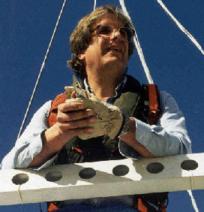When most people think of hot air balloons they think of colorful, romantic
flights taken on vacation in wine growing regions. Delicate flower
patterned balloons flying gently, while passengers sip champagne. In Julian
Nott's ballooning world, the picture is extraordinarily different. Enduring
uninterrupted flights of several days without touching down, skirting
thunderstorms and flying over the Sahara Desert, Nott has broken 79 world
ballooning records. His patented balloon designs use the most advanced
technology and he has created the first entirely new type of balloon in
over two centuries.
Balloons have been in use for 220 years and their applications continue to
develop. More balloons are flown today than at any time in history. Tiny
weather balloons make forecasting possible, central to so much human
activity. At the opposite end of the spectrum, vastly larger balloons are
routinely flown today, and for much longer periods, than at any time in
history. At 120,000 feet, so little of the atmosphere is left that it is
possible to make many observations just as effectively as from satellites.
The instruments carried by some of these giant balloons are of special
interest at KITP. The Nobel Prize for physics announced in October 2006,
was for measurements of the cosmic microwave background radiation made with
the COBE satellite. Precursor instruments for COBE were tested at the very
top of the atmosphere under giant balloons before the satellite was launched.
Penzias and Wilson's discovery of the cosmic microwave background was first
confirmed with an experiment carried under a huge balloon. Experiments on
cosmic rays, antimatter searches etc., are currently flown under giant
balloons.
In addition to his own projects, Nott's illustrated lecture covers these
achievements, the fascinating history of ballooning and the current wide
application of balloons in science and technology. Nott presents the
history of ballooning as a microcosm of the history of science and
technology, and suggests that there are lessons of intellectual courage to
be learned, central to all major human advances, and particularly to
scientists exploring the greatest of the uncharted unknowns, the future.

Julian Nott
The Smithsonian Air and Space Museum has described Nott as "the leading figure
in applying modern science to manned balloon design over the last 20 years" and
he is the recipient of numbers of leading awards. As well as designing and piloting
numerous novel balloons, he is extensively involved in scientific and commercial
applications of balloons and airships. Nott is helping NASA develop the "Pumpkin
Balloon" for very long duration, a concept Nott pioneered. Perhaps the most
interesting of his current work is assisting the NASA Jet Propulsion Laboratory to
develop balloons to explore Saturn's scientifically fascinating moon, Titan.
Audio of introduction by David Gross.

To download: Right-click and choose "Save Link As..." (Other video options)
To begin viewing slides, click on the first slide below.
![[01]](tn/01.jpg)
![[02]](tn/02.jpg)
![[03]](tn/03.jpg)
![[03b]](tn/03b.jpg)
![[04]](tn/04.jpg)
![[05]](tn/05.jpg)
![[06]](tn/06.jpg)
![[07]](tn/07.jpg)
![[08]](tn/08.jpg)
![[09]](tn/09.jpg)
![[10]](tn/10.jpg)
![[11]](tn/11.jpg)
![[12]](tn/12.jpg)
![[13]](tn/13.jpg)
![[14]](tn/14.jpg)
![[15]](tn/15.jpg)
![[16]](tn/16.jpg)
![[17]](tn/17.jpg)
![[18]](tn/18.jpg)
![[19]](tn/19.jpg)
![[20]](tn/20.jpg)
![[21]](tn/21.jpg)
![[22]](tn/22.jpg)
![[23]](tn/23.jpg)
![[24]](tn/24.jpg)
![[25]](tn/25.jpg)
![[26]](tn/26.jpg)
![[27]](tn/27.jpg)
![[28]](tn/28.jpg)
![[29]](tn/29.jpg)
![[30]](tn/30.jpg)
![[31]](tn/31.jpg)
![[32]](tn/32.jpg)
![[33]](tn/33.jpg)
![[34]](tn/34.jpg)
![[35]](tn/35.jpg)
![[36]](tn/36.jpg)
![[37]](tn/37.jpg)
![[38]](tn/38.jpg)
![[39]](tn/39.jpg)
![[40]](tn/40.jpg)
![[41]](tn/41.jpg)
![[42]](tn/42.jpg)
![[43]](tn/43.jpg)
![[44]](tn/44.jpg)
![[45]](tn/45.jpg)
![[46]](tn/46.jpg)
![[47]](tn/47.jpg)
![[48]](tn/48.jpg)
![[49]](tn/49.jpg)
![[50]](tn/50.jpg)
![[51]](tn/51.jpg)
![[52]](tn/52.jpg)
![[53]](tn/53.jpg)
![[54]](tn/54.jpg)
![[55]](tn/55.jpg)
![[56]](tn/56.jpg)
![[57]](tn/57.jpg)
![[58]](tn/58.jpg)
![[59]](tn/59.jpg)
![[60]](tn/60.jpg)
![[61]](tn/61.jpg)
![[62]](tn/62.jpg)
![[63]](tn/63.jpg)
![[64]](tn/64.jpg)
![[64b]](tn/64b.jpg)
![[65]](tn/65.jpg)
![[66]](tn/66.jpg)
![[67]](tn/67.jpg)
![[68]](tn/68.jpg)
![[69]](tn/69.jpg)
![[70]](tn/70.jpg)
![[71]](tn/71.jpg)
![[72]](tn/72.jpg)
![[73]](tn/73.jpg)
![[75]](tn/75.jpg)
![[77]](tn/77.jpg)
![[78]](tn/78.jpg)
![[79]](tn/79.jpg)
![[80]](tn/80.jpg)
![[81]](tn/81.jpg)
![[82]](tn/82.jpg)
![[83]](tn/83.jpg)
![[84]](tn/84.jpg)
![[85]](tn/85.jpg)
![[86]](tn/86.jpg)
![[87]](tn/87.jpg)
![[88]](tn/88.jpg)
![[89]](tn/89.jpg)
![[90]](tn/90.jpg)
![[91]](tn/91.jpg)
![[92]](tn/92.jpg)
![[93]](tn/93.jpg)
![[94]](tn/94.jpg)
![[95]](tn/95.jpg)
![[96]](tn/96.jpg)
![[97]](tn/97.jpg)
![[98]](tn/98.jpg)
![[99]](tn/99.jpg)
![[100]](tn/100.jpg)
![[101]](tn/101.jpg)